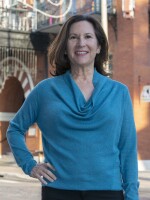
Several hundred people gathered Tuesday to celebrate the construction of Florida Polytechnic University's signature building, designed by famed architect Santiago Calatrava.
A "topping out" ceremony is a rite of passage and a kind of blessing for a major building, similar to christening a ship. Hundreds of people stood in in the muggy heat of a rural pasture alongside I-4 in Polk County, and watched as a crane lifted a steel beam onto the top of the Innovation, Science and Technology building at the future Florida Polytechnic University.
Florida Polytechnic Board of Trustees chairman Rob Gidel told the crowd that "it has been hard, but no great idea has ever been born with overwhelming support… It takes persistence, and perseverance, and faith, and hope, and that's what you see behind you."
The building's steel frame is finished. When the rest is complete, the iconic structure will be a huge, delicate oval surrounded by a lake -- sort of a cross between a flying saucer and a sea anemone. With 160,000 square feet, it will hold classrooms, labs, auditoriums, and offices.
This first building for Florida Polytechnic is expected to be completed by June of 2014, with students arriving on campus just a couple of months after that. Critics of the university have been skeptical of that timeline, but Florida Polytechnic chief operating officer Ava Parker is optimistic.

"What we're building at Florida Poly is so different and unique that students who are really interested in innovation and interested in technology and want something on the cutting edge are going to come to this university," Parker said.
Parker and Florida Polytechnic trustees have been fighting for funding and recognition. A year after Gov. Scott signed the 12th state university into law, they continue to find themselves defending their right to exist.
Because creating the state's 12th university involved closing a USF branch campus in Lakeland and reallocating those state funds, the progress of Florida Polytechnic is under close scrutiny from some Tampa area lawmakers and others. They bitterly opposed its creation and are still ambivalent, at best, about state funding for the university -- but Parker says she can win them over.
"I see our university as a jobs university, with a focus on high tech. And because we're new, and we have the opportunity to build our program in conjunction with industry, it's a unique model that will be a benefit to the system. And when I talk to legislators about how we can be an economic engine for the state, I think they're impressed with our program."
The state senate had originally included no money in their budget for Florida Poly -- now they've upped that to $16 million of the $22.4 million Florida Poly anticipated. But there are a few more weeks left in the legislative session, and Parker says she's still hoping to get the school's recurring budget fully restored.
Former state Sen. J.D. Alexander, watching from the sidelines at the topping out ceremony, said it'll happen.
"I think when the dust settles between the house and the senate it'll be in fine shape," Alexander said.

The politically polarizing Alexander fought hard to create Florida Poly as one of his last acts in the state senate. Opponents accuse him of acting in self interest, but Alexander responds that Florida didn't have a Polytechnic, and needed one:
"In Florida, we need that desperately -- to transform our economy from tourism, agriculture and home building to something broader that will support a quality of life that we like. …unfortunately it is changing the status quo, so has been hard, but I believe fervently that this will be one of the transformational institutions for our region and our state."
Spanish architect Calatrava attended the topping out ceremony. Calatrava's other current projects include a new World Trade Center transportation hub in New York, and the Denver International Airport. At the topping out ceremony, he likened his building to planting a tree, for the benefit of future generations.












